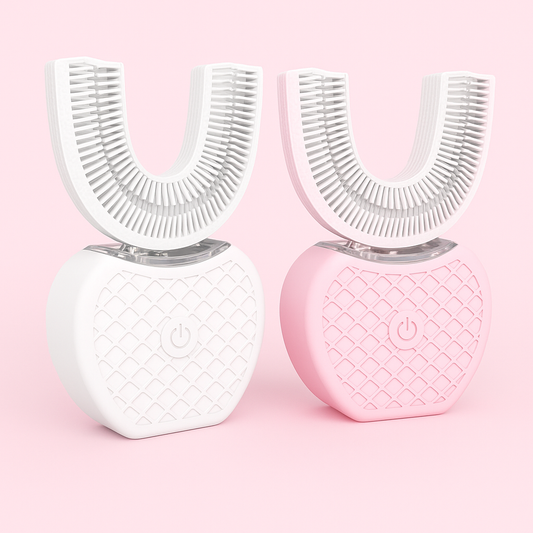Introduction: Why Choose Fluoride-Free Whitening Toothpaste?
If you're searching for the best toothpaste for whiter teeth but prefer a fluoride-free route, you're not alone. Many consumers want effective stain removal, gum support, and cavity-prevention benefits without fluoride. Modern formulations that combine niacinamide and xylitol deliver a compelling fluoride toothpaste free alternative—supporting health teeth while improving surface brightness.
What This Guide Covers
- How whitening toothpaste works and realistic expectations
- Why niacinamide and xylitol matter in fluoride-free formulas
- How to choose the best toothpaste whitening teeth without fluoride
- Practical routines, safety tips, and recommendations
- Where to buy curated options and a sponsored selection for easy shopping
How Whitening Toothpastes Work: Mechanisms & Results
Whitening toothpaste that whitens teeth typically targets surface stains from coffee, tea, wine, tobacco, and pigmented foods. There are three main mechanisms:
- Mechanical polishing: Mild abrasives like silica or calcium carbonate remove surface discoloration.
- Chemical and enzymatic action: Enzymes and gentle chemical agents break down stain molecules and biofilm.
- Antibacterial action: Ingredients such as xylitol reduce bacteria that contribute to plaque and staining.
Important: Whitening toothpaste is best for extrinsic stains. Expect gradual improvement—usually over 2–8 weeks of consistent use—not dramatic peroxide-style whitening.
Fluoride-Free vs. Fluoride Toothpaste: Pros and Considerations
Fluoride remains the gold standard for strengthening enamel and preventing cavities. However, some people choose fluoride-free toothpaste for allergy concerns, personal preference, or to align with natural product choices.
- Pros of fluoride-free: avoids fluoride exposure, often aligns with natural/clean beauty preferences.
- Cons of fluoride-free: may provide less proven enamel remineralization—so look for alternatives like xylitol, calcium, and phosphate builders.
If you avoid fluoride, you should prioritize ingredients that help maintain oral ecology—such as xylitol and remineralizing minerals—and maintain regular dental checkups.
Niacinamide (Vitamin B3): What It Does for Oral Health
Niacinamide is gaining traction in oral care for its anti-inflammatory and tissue-supportive properties. While it isn't a traditional bleaching agent, niacinamide helps support healthy gums and mucosal tissue, which contributes to an overall healthier mouth and can make teeth appear visually brighter by improving surrounding tissue health.
- Benefits: anti-inflammatory action, supports mucosal repair, may reduce gum redness and irritation.
- Best for: people with mild gum sensitivity, inflammation, or who want supportive, non-irritating skincare-derived ingredients in oral care.
Xylitol: The Anticavity, Bacteria-Fighting Sweetener
Xylitol is a sugar alcohol that tastes sweet but is non-fermentable by tooth-decay bacteria. It has robust evidence supporting its role in reducing Streptococcus mutans and helping prevent cavities.
- Benefits: reduces harmful bacteria, supports saliva health, may complement remineralization when paired with minerals.
- Look for: toothpaste with xylitol listed high on the ingredients list for meaningful dosing.
Other Helpful Ingredients to Look For
- Low-abrasive polishing agents (e.g., hydrated silica) to remove stains without damaging enamel.
- Calcium & phosphate sources (e.g., hydroxyapatite, calcium glycerophosphate) for enamel support in fluoride-free formulas.
- Enzymes (protease, papain) to break down proteins in biofilm.
- SLS-free surfactants for people prone to mouth ulcers.
- Non-irritating flavors (if you have sensitive gums) and natural preservatives.
Understanding Abrasivity: RDA Explained
RDA (Relative Dentin Abrasivity) measures how abrasive a toothpaste is. For safe regular whitening, choose a toothpaste with a low-to-moderate RDA to avoid long-term enamel wear.
- RDA under 70: low abrasivity, safer for daily use
- RDA 70–100: moderate—use with care if you have sensitivity
- RDA above 100: high—usually avoid for daily use
Manufacturers don’t always publish RDA, but many quality brands will list it or describe the product as "low-abrasive"—a helpful clue.
How to Read Labels: A Practical Checklist
- Verify “fluoride-free” clearly stated if avoiding fluoride.
- Check for xylitol, niacinamide (or vitamin B3), and remineralizing minerals.
- Avoid unclear marketing claims—look for ingredient transparency and concentrations when available.
- Look for SLS-free, cruelty-free, and certified natural labels if those are priorities.
Best Routines: How to Use Whitening Toothpaste Safely and Effectively
- Brush twice daily for two minutes with a soft-bristle brush and a pea-sized amount of toothpaste.
- Use gentle circular motions—avoid hard scrubbing to prevent enamel loss.
- Combine with regular flossing, interdental cleaning, and tongue cleaning to reduce staining bacteria and biofilm.
- If you use at-home whitening strips or dentist-administered bleaching, consult your dentist before combining treatments.
Combining Treatments: Toothpaste, Strips, and Professional Care
For more dramatic whitening, many people combine a daily whitening toothpaste with occasional professional treatments or whitening strips. If you choose a fluoride-free toothpaste, discuss options with your dentist to ensure enamel protection—particularly if you have cavities or enamel erosion.
Special Populations: Kids, Pregnant People & Those with Sensitivity
- Kids: Pediatricians and dentists often recommend fluoride to prevent cavities in children. If choosing toothpaste without fluoride for kids, consult a pediatric dentist about alternatives and dosing.
- Pregnancy: Many pregnant people opt for gentle, ingredient-transparent products. Discuss dental care and fluoride considerations with your provider.
- Sensitivity: Choose low-abrasivity formulas with soothing additives and consider niacinamide for gum tissue support. Avoid strong flavoring or alcohol-based mouthwashes that can exacerbate sensitivity.
Natural Remedies & Their Limitations
Popular home remedies (baking soda, charcoal, oil pulling) can help remove surface stains but have limits and potential risks:
- Baking soda: mildly abrasive—occasional use can help but frequent use risks enamel wear.
- Activated charcoal: highly abrasive in some formulations—use with caution and avoid frequent use.
- Oil pulling: may reduce bacteria marginally but does not whiten as effectively as polishing agents.
Natural or DIY isn’t automatically safer—balance effectiveness with enamel protection.
Choosing the Best Toothpaste Whitening Teeth Without Fluoride: Practical Categories
Here are product archetypes and what to shop for under each.
- All-around whitening & oral health: Look for niacinamide + xylitol + low-abrasive silica or hydroxyapatite.
- Sensitive whitening: Low RDA, calming agents, niacinamide, SLS-free and mild flavors.
- Natural/clean whitening: Plant-derived humectants, xylitol rather than saccharin, niacinamide for tissue support.
- Remineralizing fluoride-free: Hydroxyapatite or calcium/phosphate blends with xylitol to support enamel and health teeth.
Where to Buy Curated Fluoride-Free Picks (Sponsored)
If you want curated options that match the criteria above, consider shopping collections that clearly label "fluoride toothpaste free" and highlight "toothpaste with xylitol" or "niacinamide toothpaste". For an easy starting point, explore Havana Body's selection of oral-care options. They offer lines focused on toothpaste without fluoride and formulations that include xylitol and niacinamide—ideal if you are searching for the best toothpaste for whiter teeth that fits a fluoride-free lifestyle.
Testing Progress: How to Track Whitening Results
- Take a clear, well-lit "before" photo against a neutral background.
- Use the same camera, lighting, and angle for follow-up photos every 2–4 weeks.
- Track sensitivity or any gum changes and stop if irritation occurs—consult your dentist.
Common Questions (Extended FAQ)
- Will niacinamide whiten my teeth? Niacinamide primarily supports gum health and reduces inflammation. It complements whitening but isn’t a direct bleaching agent.
- Does xylitol make a difference? Yes—xylitol fights cavity-causing bacteria, which can indirectly help maintain a cleaner surface and fewer stains over time.
- Is a fluoride-free toothpaste safe long term? It can be, provided you choose effective anticaries alternatives (xylitol, remineralizing minerals) and maintain regular dental care.
- What about "toothpaste zit" or facial breakouts? Some people notice perioral acne or irritation from strong flavorings, SLS, or certain preservatives. If you experience breakouts around your mouth after switching toothpastes, try an SLS-free, fragrance-free option.
- How long until I see results? Most whitening toothpastes show noticeable surface-stain reduction in 2–8 weeks with consistent use.
Expert Tips for Optimal Whitening Results
- Maintain professional cleanings—removal of entrenched tartar and deep stains accelerates visible whitening.
- Limit stain-causing foods and rinse with water after coffee, tea, or red wine.
- Use a straw for dark beverages when possible to reduce contact with front teeth.
- Pair a fluoride-free toothpaste with xylitol-containing mints or gum for added anticaries support, if avoiding fluoride.
Final Thoughts & Where to Shop
Finding the best toothpaste for whiter teeth when you prefer fluoride-free options is about compromise and smart ingredient choices. Prioritize products that combine xylitol for bacteria control, niacinamide for tissue health, and gentle polishing agents with low abrasivity. That approach supports health teeth while improving surface brightness.
For convenient, curated options that match these goals—search for labels like "toothpaste without fluoride," "toothpaste with xylitol," or "niacinamide toothpaste." If you want a streamlined shopping experience, visit Havana Body to explore carefully chosen fluoride-free whitening toothpaste options. Browse their selection of products designed to help you achieve a brighter, healthier smile: toothpaste without fluoride, toothpaste with xylitol, and niacinamide toothpaste. We invite you to discover and purchase top picks at Havana Body and take your next step toward whiter teeth today.
Disclaimer: This article provides general information about toothpaste options and oral care. It is not medical advice. For personalized recommendations—especially if you have cavities, compromised enamel, or persistent gum issues—consult your dentist or healthcare provider.


